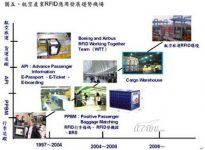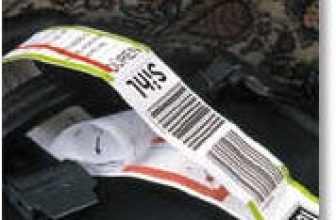
Application of RFID in global airports
[ad_1]
The Federal Aviation Administration (FAA), in response to terrorist attacks that often use non-carry-on luggage to place bombs to destroy aircraft, has started to introduce RFID technology into international airports since 1997 to target passengers travelling on international routes. Expand the verification plan for Passenger/Bag Matching and Baggage Sortation.
Under the influence of the 9/11 terrorist incident in the United States, in order to prevent various terrorist attacks, various countries have planned and established how to strengthen homeland security and increase airport security inspection measures, making RFID technology widely introduced in the global aviation industry for verification and application , Relevant plans cover passengers, luggage, cargo, maintenance and asset management, etc. Passenger passports, luggage barcodes, boarding passes, air cargo, airport assets, personnel, transportation, maintenance and duty-free goods inside and outside the airport are all imported into electronic Volume label. The promotion of aviation RFID technology can also include applications such as freight, container, ground handling, equipment, transportation, warehousing, aircraft maintenance and asset management. The development trend of RFID aviation industry application is shown in Figure 5.

From the perspective of the overall needs of airport security, the development of RFID technology in the future of air travel security is quite promising. Although there are some potential issues to be overcome in RFID technology, manufacturing process and cost at this stage, it is believed that at the speed of today’s technological development, It’s just a matter of time. RFID has the advantages of light weight, small size, digital information, wireless communication transmission and encryption technology. In recent years, after the 9/11 terrorist attack, the world has greatly strengthened airport security, improved airport service quality, and provided safe and fast luggage to ensure travel safety. Under the influence of factors such as processing efficiency, rapid and accurate passenger tracking, convenient and accurate air cargo transportation, IATA policies and international trends, international airports in neighboring countries such as Japan, Hong Kong, South Korea and Singapore have successively introduced RFID technology into airports to solve the problem. Existing problems at airports (airport congestion, poor baggage handling efficiency, etc.), strengthening travel security, improving airport service efficiency, and keeping up with global development trends. The application of RFID technology in air travel security will be the trend of the times. Therefore, it is an appropriate time to verify the feasibility of the baggage RFID system at the Zhongzheng Airport terminal on a small scale at this time.
US FAA’s RFID program
After the 9/11 terrorist incident in the United States that used aircraft as a bomb attack, the biggest change in global civil aviation is the significant strengthening of security inspection measures in airports. One of the most important items is to speed up the confirmation of luggage safety and ensure that the aircraft is not unmanned (no The baggage of passengers or passengers who have not boarded the plane is the promotion of the Passenger Baggage Match (PPBM).
According to official US statistics, the 9/11 attack by terrorists using airplanes as weapons is a special case, and the number of deaths caused by bombs built in non-passenger’s baggage to destroy airplanes between 1985 and 1989 approached 1,000. For this reason, baggage screening has become more important. The FAA has launched a PPBM series verification program using RFID technology on international routes in order to effectively prevent such terrorist attacks. , The checked luggage under the passenger’s name must be evacuated from the plane to prevent terrorist attacks. The PPBM program has been tested with 11 airlines, 8,000 flights and nearly 75,000 passengers.
The verification procedure for PPBM is as follows:
1. Departing passengers arrive at the check-in counter for check-in and check-in non-carry-on baggage, and the airline personnel write the relevant information of the baggage into the RFID Tag and insert the baggage barcode;
2. X-ray inspection of luggage;
3. The baggage is sent to the baggage automatic sorting system (Baggage Handling System; BHS) through the conveyor belt for classification and loading to the appropriate flight;
4. Send the luggage locker to the plane to confirm and track the luggage;
5. Identify and search for unboarded passengers, and remove suspicious baggage quickly if necessary.
RFID program at McCarran International Airport in the United States
McCarran Airport in Las Vegas is the seventh-busiest international airport in the United States, with approximately 700 million passengers and more than 460 flights taking off and landing every day. It has been planned to introduce RFID technology into the baggage handling system. McCarran International Airport is the first in the United States to fully adopt the U.S. Transportation Security Administration (TSA) hazardous materials inspection system to detect baggage safety requirements and introduce RFID on a large scale. A technical airport is used to meet the security provisions of the US federal government and reduce the rate of airport baggage loss.
Plan: A five-year plan was launched in April 2004
Plan goal: to strengthen airport security measures, improve passenger satisfaction, increase passenger and employee safety, and accelerate baggage handling efficiency.
Number of tags: 100 million tags.
Reading accuracy: planning up to 99.7% (Barcode accuracy is about 85~89%)
Process: When departing passengers check in at the counter, the electronic tag with RFID will be printed and affixed to the baggage, and the reader installed on the conveyor belt when passing through the conveyor belt will send the baggage to the appropriate information according to the tag. On the flight.
Japan’s Narita Airport RFID Project
The Ministry of Land, Infrastructure, Transport and Tourism of Japan started a pilot plan to introduce RFID technology at Narita Airport in March 2004 to implement “hands-on travel”. This plan is one of the “Electronic Airport Concepts” promoted by Japan. It is participated by Narita Airport, Japan Airlines, All Nippon Airways, Sagawa Express, Fukuyama Express, NTT DAT and other units. It plans to verify that the luggage material and shape are different. The reading rate of RFID electronic tags and information can be quickly and correctly transmitted in related industries (such as airport management systems, airline check-in systems, home delivery service delivery management systems, etc.).
Operation period: The test will be launched from March 1st to 25th, 2003.
Number of participating passengers: 750.
Plan goal: To solve the small space of the airport terminal, it is expected that passengers will not carry luggage at the airport and strengthen airport security checks.
Test quantity: 7500 tags.
Test countries: Hong Kong, Singapore, San Francisco and Vancouver Airport.
Reading success rate: 93%
The operation process of RFID baggage inspection is as follows:
1. Passengers can first hand over their luggage with RFID electronic tags to the baggage consignment company at the airport.
2. The baggage is first sent to the collection center, and after obtaining the information, it is sent to the inspection system through the and or management system.
3. The airport supporting baggage company sends the baggage to the airline for security inspection, and writes the inspection data into the RFID Tag.
4. After the passenger completes the check-in procedure, the luggage will be sent to the conveyor belt.
5. Install an RFID reader in the conveyor belt to confirm that the luggage is safe.
6. According to the information in the tag, the baggage is sorted and loaded onto the appropriate flight.
Korea Airport RFID Program
South Korea Airports Corporation announced that five airports in South Korea will begin to import luggage into the RFID technology verification program in May 2005. The goal of the plan is to strengthen airport security checks, reduce the threat of terrorism, and improve the efficiency of luggage transportation. The airline participating in the test is South Korea’s second largest airline, Asiana Airlines. The test scope covers five airports from Jeju to Gimpo, Gimhae, Daegu, Cheongju and Gwangju with RFID electronics Volume label.
The operation process is as follows:
1. Asiana Airlines will assign a unique RFID Tag code to each passenger at the entrance of the airport.
2. The baggage has undergone necessary safety inspections.
3. Check baggage and passenger information. Once a blacklisted passenger is found, a warning will be issued when the baggage passes through the checkpoint of the RFID reader to remind the relevant personnel to conduct a strict inspection
4. The safe and carefree baggage is sent to the baggage handling area for classification and loading on the appropriate flight.
5. Conversely, when the baggage of the arriving flight passes through, the baggage sub-carousel is equipped with an RFID reader to make it easy for passengers to find their baggage.
Hong Kong International Airport RFID Project
Hong Kong International Airport is currently China’s main airport for transit in and out of the mainland (Hub Airport). This airport is used by about 35 million passengers a year, of which transit baggage accounts for about 40% of the total transport volume. In order to ensure the airport’s transshipment status in mainland China and enhance its competitiveness, the Hong Kong Airport Authority decided on June 11, 2004 to introduce RFID technology into baggage processing security and tracking in a comprehensive and phased manner.
Planned schedule: Planning and construction in 2004, and testing started on January 1, 2005. At this stage, the luggage tagging system is parallel to the Barcode and RFID system.
Plan size: 120 rewritable readers and 1.5 million tags will be installed in stages; 80 million tags will be planned in the next five years.
Plan goals: reduce the rate of baggage loss based on passenger considerations; improve flight safety, strengthen baggage security inspection operations after the 911 terrorist attack; reduce airport handling costs, and simplify baggage handling labor costs.
Plan scope: Baggage Tag, Baggage Track, Boarding Pass, Employee Pass.
The operating process of the Hong Kong Airport Baggage Handling and Security System after the introduction of RFID technology is shown in Figure 7, and the brief description is as follows:
1. Departing passengers will check in their non-carry-on luggage at the check-in counter.
2. The staff will send the luggage to the security check area.
3. If the baggage has undergone X-ray inspection, and the contents of the baggage cannot be clarified three times, the message will be written into the Tag and sent to the unknown baggage handling area for manual inspection.
4. When the baggage is sent to the conveyor belt (Luggage Handling Conveyor), the machine will automatically stick the RFID Tag of the baggage strip (Baggage Strip) on each piece of baggage, and the barcode scanner will read the Barcode data, and IATA baggage The service message (Baggage Service Message; BSM) code is also written into the RFID Tag at the same time.
5. The baggage is sent to the baggage sorting system (BHS) through the conveyor belt for classification and loading.
6. When the baggage check-in vehicle sends the baggage to the baggage door of the flight, the RFID reader confirms the number of baggage and whether there is any unknown baggage.
7. Confirm that the passenger and luggage are boarding at the same time.

US TSA applauds the role of RFID in airport vehicle management
The United States Transportation Safety Administration (TSA) recently published a report on the RFID test conducted at Newark Liberty International Airport. This test is about the tracking of baggage, fuel trucks and other vehicles at the airport. In this report, TSA recommends the use of RFID as a technical means to ensure the safety of airport ground transportation, especially fuel vehicles. The airport can use this RFID management system to improve transportation safety and combat terrorists.
This report is the result of a $4.1 million RFID trial conducted by TSA at Newark Airport and JAXPORT Seaport in Florida. ID Systems is an American supplier of RFID-based wireless asset tracking and management solutions, providing software and hardware support for this RFID system.
The wireless asset management network is composed of intelligent wireless devices (installed on industrial vehicles, such as forklifts, pallet trucks), patented communication infrastructure, and customer-specific server software (which can realize access control management, efficiency analysis, real-time location tracking, etc.) composition.
At Newark International Airport, IDSystems’ wireless network system can supervise 80 cars at the same time, and each car is equipped with an RFID card reader named Vehicle Asset Communicator (RFID Radio Frequency Newsletter Note: Vehicle Asset Communicator——VAC) . The driver wears an ID badge embedded with an active RFID tag with a working frequency band of 900MHz. From the moment the car starts, the VAC can monitor the badge information on the driver.
In order to accurately and effectively track the relevant information of the driver and the car, each car has a GPS unit connected to the VAC. The VAC transmits a 900MHZ signal and monitors the position of the car through the ID Systems system. The ID system is connected to the wireless 2.4G LAN network. . The maximum information transmission range can reach 1,000 feet. In the TSA report, Newark’s RFID system can track 95 cars at the same time. This project is jointly organized by TSA, the US Federal Government’s Department of Homeland Security and TSA’s Safe Transportation Laboratory.
TSA’s technical director James Heimer said, “The most important thing about this experiment is the successful integration of wireless technology and real-world applications in the positioning system, which can provide security for airport transportation and lay the foundation for future research and experiments. ,”
The challenges faced by ports and airports are different, because there are a lot of data exchanges and many devices that can transmit high-frequency signals, radar systems, and ground-to-air communication systems. ID System’s marketing vice chairman Smith said that busy airports like Newark, the 900MHZ wireless transmission or resident frequency is facing greater challenges than other small airports.
Smith said, “During the two-year test at Newark Airport, the system operated as expected, and there was no interference, and it was able to coexist with high-frequency radio.” He attributed this success to the system’s low energy (1 milliwatt). ). Smith hopes that other airports and ports will also adopt this RFID management system, although it is now only used in Newark and JAXPORT.
[ad_2]





